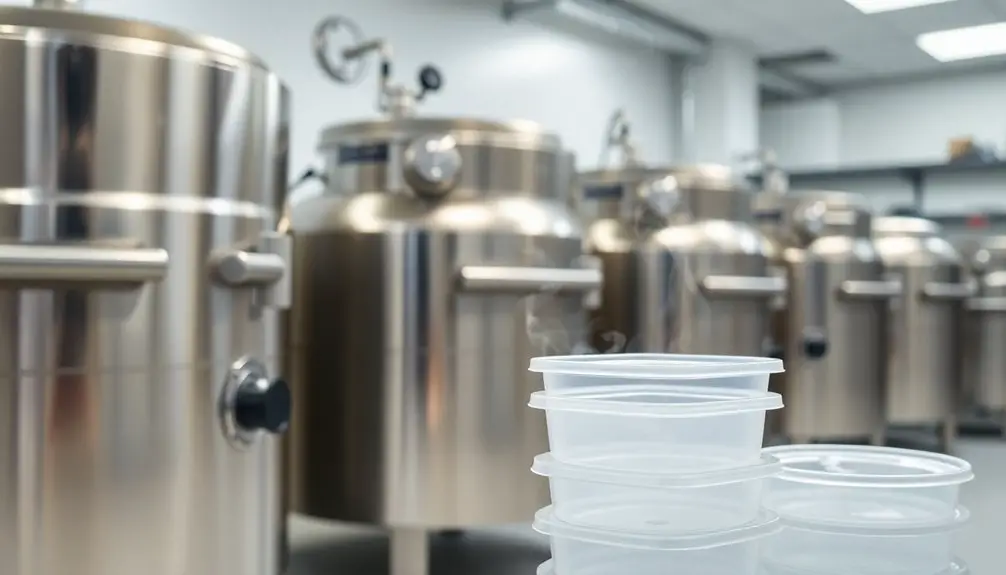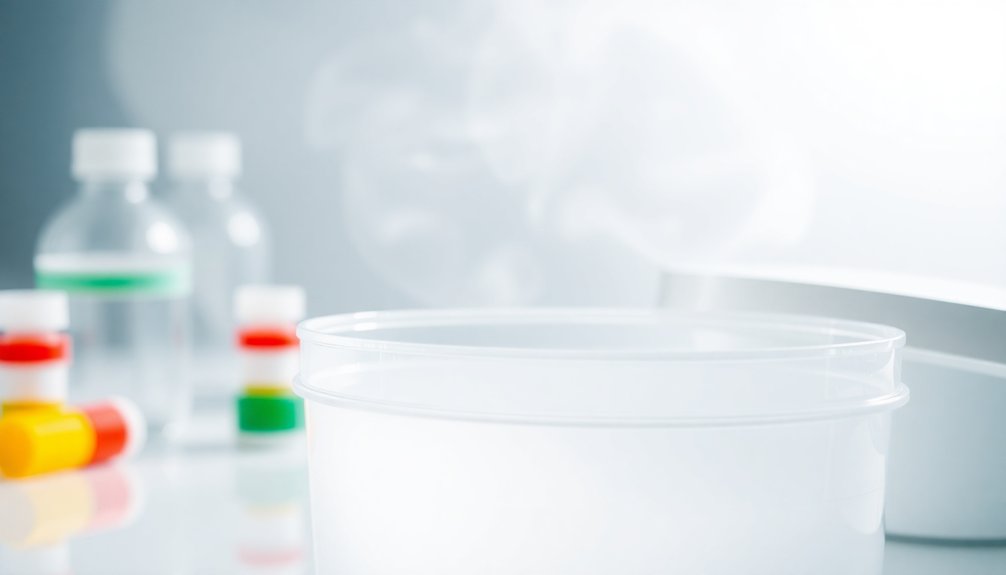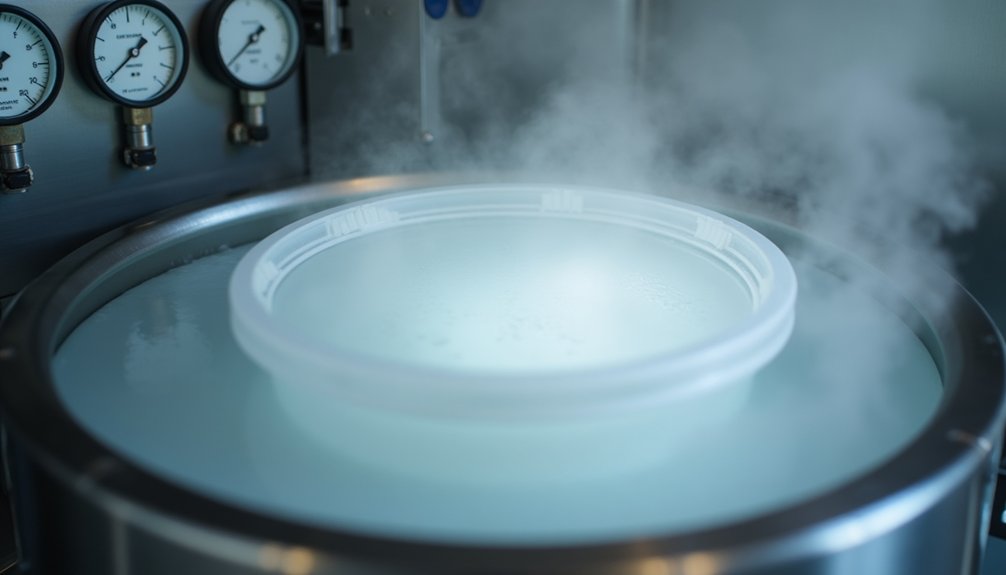Yes, you can autoclave polypropylene! This material has high heat resistance and is perfect for sterilization in lab settings. To ensure effective sterilization, set your autoclave to temperatures above 121°C while maintaining the required pressure. Before autoclaving, make sure to clean your polypropylene containers thoroughly and remove any caps to allow steam to circulate. Don't overfill them either; aim for no more than two-thirds full. Proper autoclaving not only ensures safety by eliminating microorganisms but also helps extend the life of your polypropylene items. Stay tuned for more tips on maximizing your autoclaving experience!
Key Takeaways
- Yes, polypropylene is suitable for autoclaving due to its high heat resistance and ability to withstand repeated sterilization cycles.
- Always check manufacturer guidelines to confirm specific polypropylene product compatibility with autoclaving conditions.
- Ensure caps are disengaged and containers are filled no more than two-thirds full to prevent collapse or explosions during the cycle.
- Thoroughly clean polypropylene items before autoclaving to enhance steam penetration and ensure effective sterilization.
- Inspect containers for cracks or wear prior to autoclaving to avoid failures and ensure reliable sterilization results.
Autoclaving Conditions
When considering autoclaving polypropylene, it's crucial to understand the specific conditions required for effective sterilization.
You'll want to maintain a standard temperature of 121°C (250°F) for at least 15 minutes, or opt for fast autoclaving at 134°C (273°F) with careful control. Remember, polypropylene can handle temperatures up to 121°C without significant degradation, but it transfers heat slowly. This means you need to allow adequate time to reach those sterilization temperatures.
Pressure plays a key role too; ensure you're at 15 psi during the autoclave cycle. Polypropylene can withstand this pressure without deformation, but maintaining the correct pressure is vital for effective sterilization and preventing container collapse.
Also, ensure proper steam circulation for even heating. Importantly, polypropylene labware ages over time, so be vigilant about inspecting your containers for signs of discoloration or cracks to ensure reliability.
Polypropylene is often regarded as one of the safest plastics available, with low toxicity levels and FDA approval for food use, which includes food packaging safety.
Don't overlook cycle duration—stick to a minimum of 15 minutes at 121°C. After the cycle, allow sufficient cooling time to prevent damage.
Always validate your autoclave cycle to confirm accurate temperature and pressure readings.
Lastly, follow the manufacturer's guidelines for specific recommendations on autoclaving polypropylene containers to achieve the best results.
Material Suitability
Autoclaving polypropylene is a viable option due to its general suitability for repeated sterilization without losing strength. This material boasts several key characteristics that make it an excellent choice for autoclaving in various environments.
- Heat Resistance: Polypropylene withstands high temperatures, crucial for effective sterilization.
- Sterilization Effectiveness: Autoclaving eliminates harmful microorganisms, ensuring your polypropylene products remain safe and sterile.
- Reusable: You can autoclave polypropylene multiple times, which saves costs and minimizes waste.
- Compatibility: Polypropylene can be autoclaved alongside glass, metal, and textiles, enhancing its versatility in different applications. Additionally, it's important to note that many plastics can be autoclaved at 121°C, 15 psig for 15 minutes.
However, always check the manufacturer's guidelines to ensure the specific polypropylene products you're using are suitable for autoclaving. Polypropylene's tensile strength makes it a reliable material for repeated autoclaving, and its durability contributes to its widespread use in various industries.
While polypropylene is generally durable, be mindful of potential limitations. Inspect products for any signs of wear before autoclaving, and ensure proper storage after sterilization to prevent contamination.
Best Practices for Autoclaving

Ensuring successful autoclaving of polypropylene requires careful attention to best practices that maximize sterilization effectiveness. Start by setting your autoclave to the recommended temperature, usually above 121°C, and ensure the pressure is appropriate to prevent deformation. It is also crucial to consider the heat resistance of the material being autoclaved to prevent damage. Choose the right sterilization cycle, opting for a liquid cycle for liquids and a fast exhaust cycle for glassware. Before autoclaving, clean the polypropylene tubes thoroughly, removing any debris. Take off any caps or lids to enhance steam penetration. When loading, place the tubes in autoclave-safe containers and ensure there's enough space between items for proper steam circulation. Always inspect your tubes for cracks or signs of wear before starting the process. After autoclaving, allow the tubes to cool to prevent thermal shock. Release the pressure inside the chamber before opening it to avoid accidents. Be cautious of steam burns, standing behind the door when you open it. Finally, store your autoclaved polypropylene tubes in a clean, dry location, and use them within the recommended timeframe for optimal results. Following these best practices helps ensure safe and effective sterilization. Additionally, remember that polypropylene's high heat resistance contributes to its suitability for repeated autoclaving, further enhancing its value in laboratory settings.
Benefits of Sterilization
Sterilization offers numerous benefits that can significantly impact your reproductive health and overall well-being.
By choosing sterilization, you're not just making a decision about pregnancy prevention; you're also gaining several advantages that can improve your quality of life.
Here are four key benefits:
- Permanent Pregnancy Prevention: It's over 99% effective, providing peace of mind without the need for ongoing birth control methods.
- Elimination of Other Birth Control Methods: You won't have to worry about trips to the pharmacy or side effects from contraceptives, making your lifestyle simpler and more natural. Additionally, this method provides a permanent solution for those who are certain they do not want future pregnancies.
- Health Benefits: Sterilization reduces the risk of pregnancy-related complications and prevents the passing of genetic disorders, allowing you to focus on other aspects of your life.
- Medical Considerations: Many insurance plans cover tubal ligation, and there are minimally invasive surgical options available, ensuring a smooth process.
Selecting Appropriate Containers

When choosing containers for autoclaving, it's crucial to consider material compatibility and design features that ensure effective sterilization. Polypropylene (PP) and polypropylene copolymer (PPCO) are excellent choices since they can withstand autoclaving without losing strength. However, be mindful of any chemicals that might deteriorate at high temperatures—make sure to rinse them with distilled water beforehand. The safety of propylene glycol, a common chemical used in various products, is ensured by regulatory agencies that set guidelines for acceptable intake levels.
The design of your containers is equally important. Always disengage the cap before autoclaving to prevent collapse, and ensure there's adequate venting for air circulation. Fill containers no more than two-thirds full to avoid explosions, especially with glass. Additionally, ensure that you follow manufacturer recommendations for the specific polypropylene products you are using to prevent any potential degradation.
Avoid thread engagement during the autoclave cycle to maintain a leak-proof fit. For optimal results, autoclave empty PP containers at 121°C and 15 psi for 20 minutes. After the cycle, allow enough cooling time before handling, and reassemble caps aseptically to prevent contamination.
Store your PP containers away from direct UV light to prolong their lifespan, and clean them with a pH-neutral detergent to maintain their integrity. With these guidelines, you can effectively select appropriate containers for autoclaving.
Frequently Asked Questions
Can Polypropylene Withstand Repeated Autoclaving Cycles?
Yes, polypropylene can withstand repeated autoclaving cycles, showing minimal loss in mechanical properties. However, be cautious under high-stress conditions, as its performance may decline after multiple sterilization processes. Always ensure proper cleaning before autoclaving.
What Are the Signs of Polypropylene Degradation After Autoclaving?
After autoclaving, you might notice a slight decrease in flexural rigidity and changes in viscosity. However, no brittleness or fractures typically occur, and the polypropylene's dimensions generally remain within ISO specifications despite these changes.
Is There a Maximum Number of Autoclaving Cycles for Polypropylene?
There isn't a specific maximum number of autoclaving cycles for polypropylene. You can autoclave it repeatedly without significant loss of strength, but watch for signs of aging like discoloration or crazing over time.
Can Color Additives in Polypropylene Affect Autoclaving Results?
Yes, color additives in polypropylene can affect autoclaving results. They may change the material's appearance after the process, so consider selecting compatible pigments to minimize color shifts and maintain the desired aesthetic.
What Alternative Sterilization Methods Can Be Used for Polypropylene?
You can use gas sterilization with ethylene oxide, radiation methods like gamma rays, or ozone sterilization for polypropylene. These alternatives effectively sterilize while maintaining material integrity, offering options when traditional autoclaving isn't suitable or preferred.

